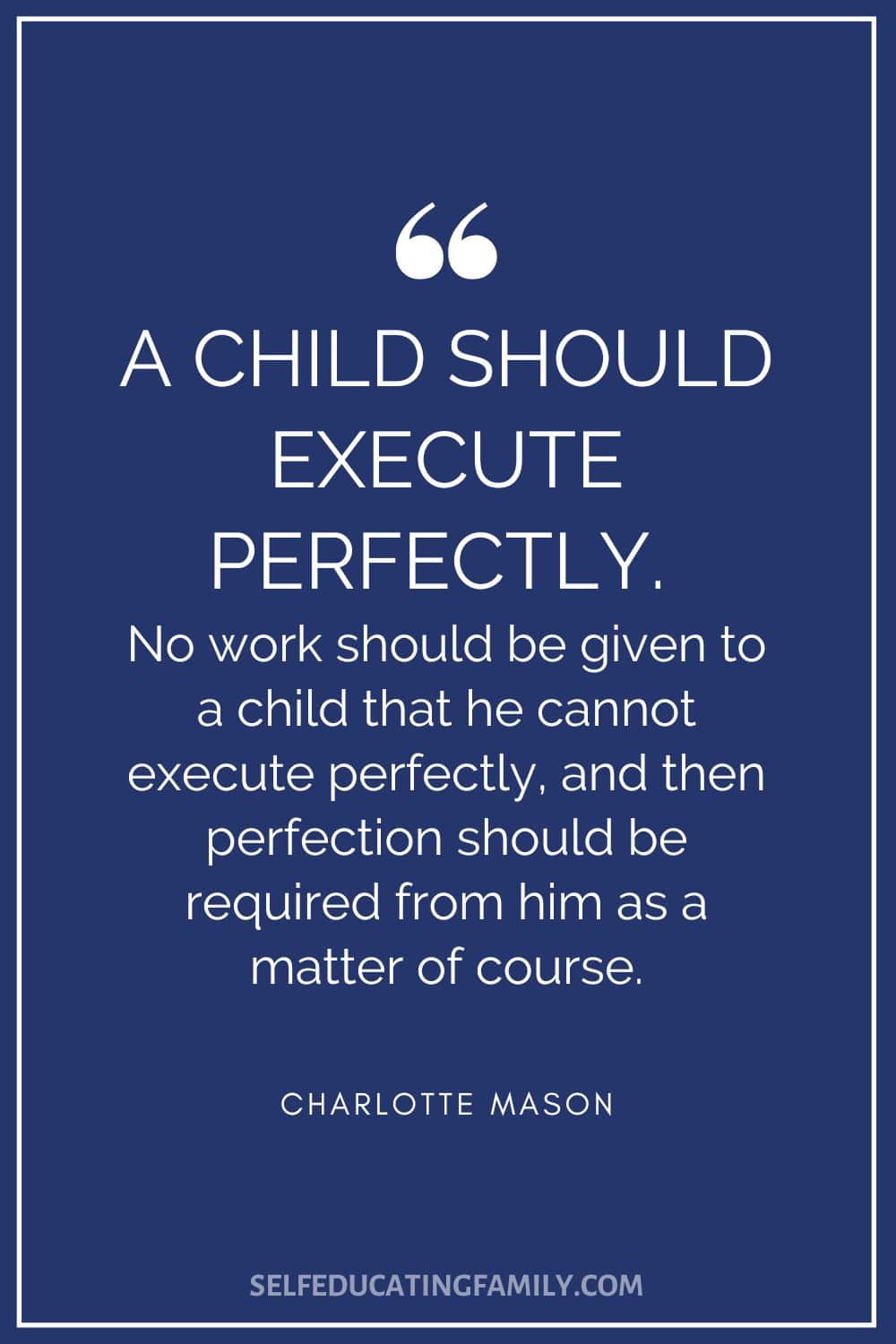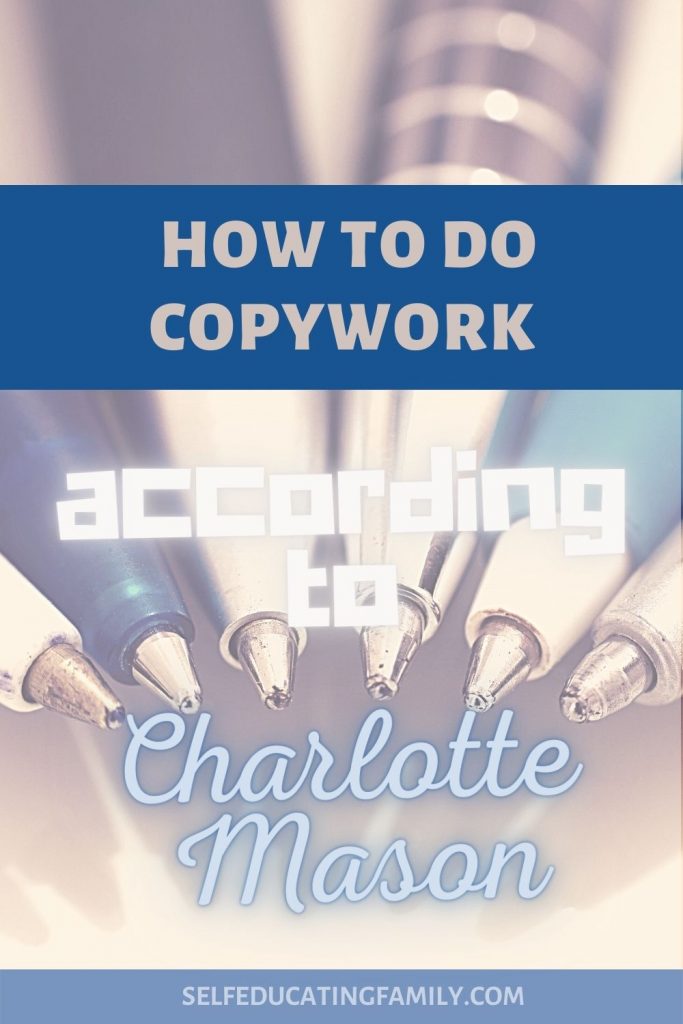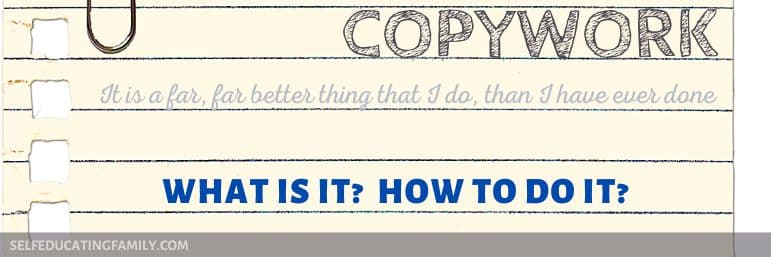What’s inside: Find out what is copywork and how you can use it in your homeschool. In print or cursive, copywork helps your child with handwriting practice at its simplest. But it can also help your child learn grammar, spelling, and writing. Grab a free copywork printable to see how it works.
What is Copywork?
Copywork is simply copying a written or dictated sentence in your own handwriting. When you are learning how to print or how to write in cursive, “copywork” consists of copying strokes and letter forms. Once you shape your letters correctly, you are ready for more formal copywork with transcription and dictation. Here is when copywork begins to shine.
What is Charlotte Mason copywork?
Let’s look, for a minute, at Charlotte Mason’s ideas of copywork. Here is her classic quote on starting with tasks which are completely within the capabilities of the child, such that the execution of the task is done “perfectly”:
A Child should Execute Perfectly. No work should be given to a child that he cannot execute perfectly, and then perfection should be required from him as a matter of course. For instance, he is set to do a copy of strokes, and is allowed to show a slateful at all sorts of slopes and all sorts of intervals; his moral sense is vitiated, his eye is injured. Set him six strokes to copy; let him, not bring a slateful, but six perfect strokes, at regular distances and at regular slopes. If he produces a faulty pair, get him to point out the fault, and persevere until he has produced his task; if he does not do it to-day, let him go on to-morrow and the next day, and when the six perfect strokes appear, let it be an occasion of triumph. So with the little tasks of painting, drawing, or construction he sets himself––let everything he does be well done. An unsteady house of cards is a thing to be ashamed of. Closely connected with this habit of ‘perfect work’ is that of finishing whatever is taken in hand. The child should rarely be allowed to set his hand to a new undertaking until the last is finished.
–Charlotte Mason, Home Schooling Series Volume 1: Home Education, page 160

Stages of Copywork
So we see that copywork is used in stages:
- At first for letter forms, making sure the child is forming the letters properly.
- Next, copying sentences in context.
- Then, transcription.
- Finally, Dictation.
Why bother? And what’s the big deal?
Each stage serves different purposes in the development of the child’s education.
Letter Forms
The youngest learners are working on muscle memory of the physical recall for each letter shape. Until the child automatically remembers how to form each letter perfectly, it is difficult to move on without producing slipshod work.
Note! I had one young learner who had classic dyslexia – in this case, development does NOT follow the normal ages and stages. This article refers to typical learners.
And another Note! Charlotte Mason refers to “slates”. Remember any movie with a schoolroom of the 1800’s? Children commonly used slates because paper was so expensive. With my kids I used an inexpensive dry erase board that had lines on it for penmanship. You can also print up some pre-printed lined paper and laminate it for the same effect.
Move on to formal copywork when the letters are formed correctly. If you are having trouble making the shapes stick to the child’s memory, I can recommend a technique from two different resources which I used with my kids: the technique is air “writing” big letters.
- Peterson Directed Handwriting: Emphasis was on using rhythm to form letters. Very helpful to us.
- Dianne Craft: Her “Writing 8” midline exercise for brain integration was extremely valuable.
Air writing cements muscle memory. I won’t go into the details here, but I just wanted you to know that there are resources out there to help if there is a hiccup in the normal learning progression. Both of these recommendations work with the regular learning progression also.
Learning correct letter forms can be called penmanship.
Copying sentences
Next, the child moves on to the more formal stage of copying sentences as soon as the letter forms are learned. The eye will copy letter by letter at this stage. You must still require perfect form.
I have to confess – here is an area I struggled with. I encourage you to persevere. I’ve seen the result in some of the kids in my homeschool coop – some beautiful handwriting in their families. Not so much in mine! I think I gave up too easily – that’s why I am encouraging you.
Vary the content of copywork – no one likes to copy the same sentence 100 times. And, again, keep it short – in time and sentence length. The child is not writing the words yet, just a bunch of letters. Each little learning step happens in sequence.
When you notice your child speeding up because they are looking at a word and then copying the whole word without checking each letter, they are ready for transcription.
Transcription
This can happen as early as age 7 or 8. With transcription, the child is still copying sentences, but now they are going word by word and spelling comes into play.
Transcription should be an introduction to spelling. Children should be encouraged to look at the word, see a picture of it with their eyes shut, and then write from memory.
Charlotte Mason Home Schooling Series, Volume 1: Home Education, p 239
The idea behind looking at the word or sentence and imprinting it on their minds is that the child won’t make spelling errors that way. In Charlotte Mason theory, sloppy work or spelling errors are things that just promote more of the same. In other words, looking at a word spelled wrong helps cement a wrong spelling.
The child will be tempted to go faster and write smaller – both danger zones for not giving their best effort. Encourage them to take their time. Give them larger lined paper if they tend to cramp up their writing.
Vary the subject. You can use smaller subjects like poetry, math, folk songs, science, or other for copywork.
Charlotte Mason suggests allowing the child to make favorite selections and copy them into their own keepsake copybook to keep them excited by the subject.
Dictation
When you move on to dictation, keep these ideas in mind:
- Dictation always involves pre-reading.
- The child must review what will be in the section to prepare mental pictures of words that might cause trouble with spelling.
- If you are dictating, ask what words the child thinks might give problems.
- Write each word one at a time on a white board, and have the child imprint it on his brain by staring at the word.
- Then, you erase the word before moving on to the next problematic word.
- After that, if the child thinks he will still have trouble, have him come to the board to write the word.
- Let the student tell you when they are ready. Dictate each clause once, and repeat once. They are responsible for punctuation (don’t say, “Comma” for instance).
- Because of this, dictation brings grammar in to play as well as spelling.
How to Do Copywork as a School Subject
Many would agree that the main subjects of an education should be “the basics” of reading, writing and arithmetic. Yet, Charlotte Mason advocates quite a number of subjects to teach to young people; including copywork as its own subject. Her approach weaves subjects together.
Copywork is related to many or almost any of the other subjects simply by the selection of material. For instance, good copywork can come from the living books you are free reading, from your literature reading, from your history book or even from the less obvious topics like science, poetry or nature study.
Whatever the content, here are some guidelines for teaching copywork as a subject.
Length per session
Keep it short! Spend 5 – 15 minutes doing copywork a day, depending on the age & stage of the child. Remember to use Charlotte Mason techniques to avoid dilly-dallying.
Times per week
Copywork can be done every day. Be sure to keep it fresh (see below for ideas).
Length of lesson
Letter forms for beginners are just trying to make correct strokes. Remember the 6 perfect strokes guideline! As copywork progresses toward transcription and dictation, the length of the sentences can get longer. Dictation can be a paragraph for a child of 8 or 9, and up to a page or two for older children.
For older learners new to copywork as a subject
As students get used to the process, it can be helpful to use the same piece of paper for reading the sentence and copying it as opposed to copying it directly from the book you are reading. This can aid very young learners also.
Remember, they are trying to copy once, beautifully. You shouldn’t add unnecessary difficulties to the task.
Remember Feedback loops!
Remember to gently guide the child to make corrections.
Find the fine line between over-perfection and a job well done. Eventually, the child will be able to judge her own output independently – but keep making sure that neither slipshod work nor ultra-perfectionism become a habit.
How does copywork relate to composition?
The general rationale behind copying great writing is that the student will eventually have good spelling and grammar and have had his writing style influenced by many of the greatest writers of all time.
Copywork, like narration, invests in the future. Composition will flow naturally out of the study of these two subjects.
Are the copy work generators any good?
Yes!
Free printable generators can be great. Here are two:
Try not to spend too much time creating a worksheet though, since it’s just a throwaway, unless you will be saving a copy for future students.
Alternates to worksheets:
- Use a copywork journal for the final beautiful copy
- Use lined white erase hand held boards for practice
- Use blank, lined paper like the kind you can download & print free from Ambleside Online, while you read your source material direct from the book.
- Use purchased blank, lined paper.
Can I make my own copywork printables?
Yes!
All you need is a font with lines. I used one called SchoolScriptDashed, which I got free from the font site called Dafont.
- WARNING: Please note! Dafont is one of the few verified trusted free font sites. Downloading “free fonts” is a notorious way to get a computer virus!
Here’s a free printable
Where can I find a source for more copywork?
In general, once the student can find appropriate copywork from their readings, they can select their favorites. That’s the long term goal. In the short run, give guidance on how long it should be and from which books. There are some other copywork resources in my free library which you can access if you sign up for my newsletter. For instance, I’ve got a two-page resource with 16 great quotes from living books or classic literature. Or here, you can see a list of high school-level living books.
Keep Learning
Related posts:
Enjoy your copywork!








